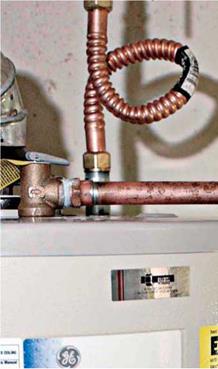AND AIR-CONDITIONING
Heating and cooling systems are varied and complex, so make your house purchase contingent on a professional inspection by an HVAC contractor. In your walk-through, look for the following:
► If the bottom of the heating unit is rusted out or if it’s 15 years to 20 years old, it probably should be replaced. It’s certainly not efficient and probably not safe.
► Soot around heat registers or exhaust smells in living areas mean that the furnace is dirty and poorly maintained or that the furnace heat exchanger is cracked, allowing exhaust gases to escape. If an HVAC specialist can see flame through the heat exchanger, it’s definitely time to replace the unit. It may be a fire safety and health hazard.
► If your house has forced hot-air heat, your family could develop respiratory problems if the furnace has one of the older, reservoir-type humidifiers, which are notorious for breeding harmful organisms in the always-wet drum. An HVAC specialist can suggest alternatives.
► If certain rooms are always cold, an HVAC specialist may be able to balance heat distribution or add registers. That failing, you’ll need to upsize the furnace or boiler.
► If ducts, pipes, or the central heating unit are wrapped with white or gray paper-tape, your older heating system may be insulated with asbestos. Do not disturb it—an HVAC specialist can assess its condition and recommend an asbestos-abatement expert.
► Air-conditioning (AC) systems that run constantly but don’t cool may need the coolant to be recharged. An AC system that cycles too rapidly and makes the house too cold may simply be too large for the house. Both problems just need adjustments by an HVAC contractor.
Loose bricks in the fireplace firebox or smoke stains between the wall and the fireplace mantel (or surround) could allow flames or superheated
|
AND EARTHQUAKES |
In earthquake country, brick chimneys may break off at the roofline, fall through the roof, and harm inhabitants. A structural engineer can analyze the chimney and suggest remedies, such as seismic steel bracing of the chimney to the roof or removing the chimney above the roof and replacing it with metal flue pipe.
gases to ignite wood framing around the fireplace. A mason or chimney specialist can usually make necessary repairs.
If there are gaps between the hearth (firebox floor) and the hearth extension, stray coals could fall into the gaps and start a fire, so repoint gaps with mortar (if there’s brick) or grout (tile floors).
Local building codes usually specify minimum distances woodstoves and stovepipes must be from flammable surfaces. Ask to see a certificate of occupancy (C. O.) issued for the existing installation. If the owner can’t produce one, make the C. O. part of your purchase agreement.
Estimating Project Difficulty and Costs
It’s hard to generalize how difficult a job will be for individual do-it-yourselfers because skills vary greatly. Still, it’s possible to suggest relative difficulties of various tasks, giving you some reference at least. Chapters or sections of this book greatly expand on the following topics.
Demolishing. Make sure your tetanus shot is up to date. Before you begin work, wear full safety gear, including hard hat, eye protection, and boots that nails can’t puncture. If you will generate dust, wear a dust mask. Also, prevent dust from migrating to other rooms by shutting or sealing door openings and air ducts with plastic. Always shut off power to an area you’re demolishing. During demolition, make sure you’re not compromising either the electrical system or the support structures. Be methodical, removing debris as you generate it, and sweep up the work site at the end of each day.
Interior painting. Preparing the walls and being fastidious are keys to success.

 Exterior painting. Rent scaffolding if it’s a two – story house. Homeowners often run planks between ladder brackets on extension ladders,
Exterior painting. Rent scaffolding if it’s a two – story house. Homeowners often run planks between ladder brackets on extension ladders,
but the job will be far safer and many times faster if you work from scaffolding. Again, surface preparation is crucial to a lasting job.
Stripping paint, inside or out. This isn’t as difficult as it is messy. Before you begin, buy a lead – paint testing kit from a building supplier. Lead paint dust and shavings are hazardous wastes and should be dealt with accordingly. Avoid open-flame paint stripping; the fire hazard is too great. Use a respirator mask with replaceable cartridges
Wallpapering. Practice on a small, out-of-the way area to get the hang of it. Wall prep is crucial. Use only the paste recommended by the wallcovering manufacturer.
Hanging drywall. This isn’t difficult if you’ve got help. Measuring carefully and getting the edges of the first sheets plumb (or level) are keys to success.
Patch repairing walls. This is generally quite easy. Sand or cut back the damaged parts to ensure a solid surface for the patch.
Insulating. Stuff or spray insulation into every nook and cranny to stop air infiltration. However, there should be air space over insulation between rafters, so that heated air under the roof can escape. Gloves, a long-sleeved shirt, a hat, and a face mask are imperative.
Weatherstripping. It’s easy but exacting work to fit the stripping snugly against doors, windows, and frames. You may be surprised how long this job takes.






Leave a reply